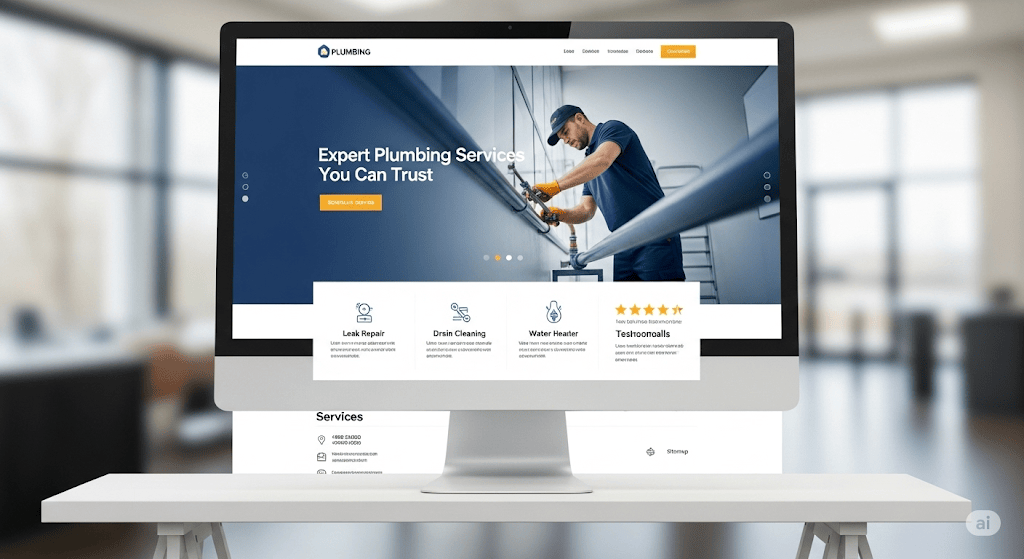
Discover how custom web design for plumbing companies can drive more leads. Learn mobile-first strategies to improve speed, UX, and local SEO rankings.
In today’s fast-paced, mobile-driven world, your plumbing business website must do more than just exist—it needs to perform. Homeowners and business owners are no longer using desktops to find local plumbers. They’re searching on mobile, often during plumbing emergencies. If your website isn’t mobile-optimized, you’re likely losing leads to competitors who are.
That’s why adopting a mobile-first strategy with custom web design for plumbing companies isn’t just recommended—it’s essential for business growth in 2025 and beyond.
In this guide, we’ll explore how to design a high-performing, mobile-optimized plumbing website that not only ranks well on Google but also turns visitors into paying customers.
Why Mobile-First Matters for Plumbers
Google now indexes the mobile version of your website first. This means your site’s mobile usability affects how it’s ranked in search engine results. For plumbers, where immediate service is often critical, a slow, clunky, or non-responsive site can mean the difference between a booked job and a lost lead.
Mobile-first design ensures that your site is:
-
Fast-loading on smartphones
-
Easy to navigate with one hand
-
Optimized for local SEO
-
Designed with conversions in mind
1. Use Custom Layouts for Better User Experience
Generic website templates may look decent on desktop but often break or feel clumsy on mobile devices. Custom web design for plumbing companies means designing from scratch—or from a flexible framework—with your brand, services, and user flow in mind.
Key mobile UX features include:
-
Sticky header with tap-to-call button
-
Simplified navigation menu (hamburger menu)
-
Scroll-friendly service sections
-
Thumb-friendly CTA buttons
A seamless experience keeps users engaged and encourages them to take action.
2. Prioritize Page Speed
Site speed is a direct Google ranking factor—and more importantly, a business killer if ignored. Mobile users expect your site to load in under 3 seconds. Anything more and bounce rates skyrocket.
Improve speed by:
-
Compressing images for mobile without losing quality
-
Using next-gen formats like WebP
-
Implementing lazy loading
-
Minimizing scripts and third-party tools
-
Hosting videos on platforms like YouTube or Vimeo
Test your mobile speed with PageSpeed Insights.
3. Optimize for Local SEO
Most plumbing searches are location-based. People type “plumber near me” or “emergency plumbing in [City].” That’s why your mobile site needs to be local SEO ready.
Best practices include:
-
Embedding Google Maps with your business location
-
Using geo-targeted service pages (e.g., “Plumbing Services in Austin, TX”)
-
Adding local schema markup for NAP (Name, Address, Phone)
-
Using click-to-call phone numbers
These tactics help your business rank in both organic results and the local pack.
4. Design CTAs for Mobile Users
On mobile, your CTA buttons need to be big enough for fingers and strategically placed for maximum visibility. Ideal mobile CTAs include:
-
“Call Now” buttons that appear immediately
-
Floating booking widgets or chatbots
-
Fixed bottom banners with discount offers or service guarantees
Don’t make users scroll endlessly to find your phone number or contact form. Guide them toward action from the start.
5. Include Trust Signals in Mobile Format
Trust is critical in the service industry. Include the following elements on your mobile site:
-
Star ratings and client testimonials
-
Business accreditations (e.g., BBB, licensed, insured)
-
Before-and-after images of recent plumbing jobs
-
Badges for warranties, 24/7 service, and satisfaction guarantees
Make sure these elements are readable and visually appealing on small screens.
6. Build with Scalable Technology
Use responsive design frameworks like Tailwind, Bootstrap, or CSS Grid. Your CMS (like WordPress or Webflow) should support mobile responsiveness and allow flexibility for growth.
Custom web design also enables integration with booking software, CRMs, and live chat—all optimized for mobile.
7. Don’t Forget Mobile Analytics
Understanding how mobile users interact with your website is key to future improvements. Use tools like:
-
Google Analytics 4 (GA4)
-
Hotjar or Microsoft Clarity (for heatmaps)
-
Google Search Console (for mobile usability issues)
Track conversions by device, session length, click-through rates on mobile CTAs, and bounce rates.
Conclusion
A mobile-first strategy is no longer optional—it’s essential for plumbing businesses that want to stay competitive and convert online traffic into leads. With custom web design for plumbing companies, you can create a responsive, SEO-ready, high-converting website tailored to your local audience’s needs.
If your plumbing website isn’t delivering leads or ranking well on Google, it may be time for a mobile-first redesign. Let your website work as hard as you do—especially when your customers are most in need.
👉 Explore our guide to plumbing website design best practices and transform your online presence.

